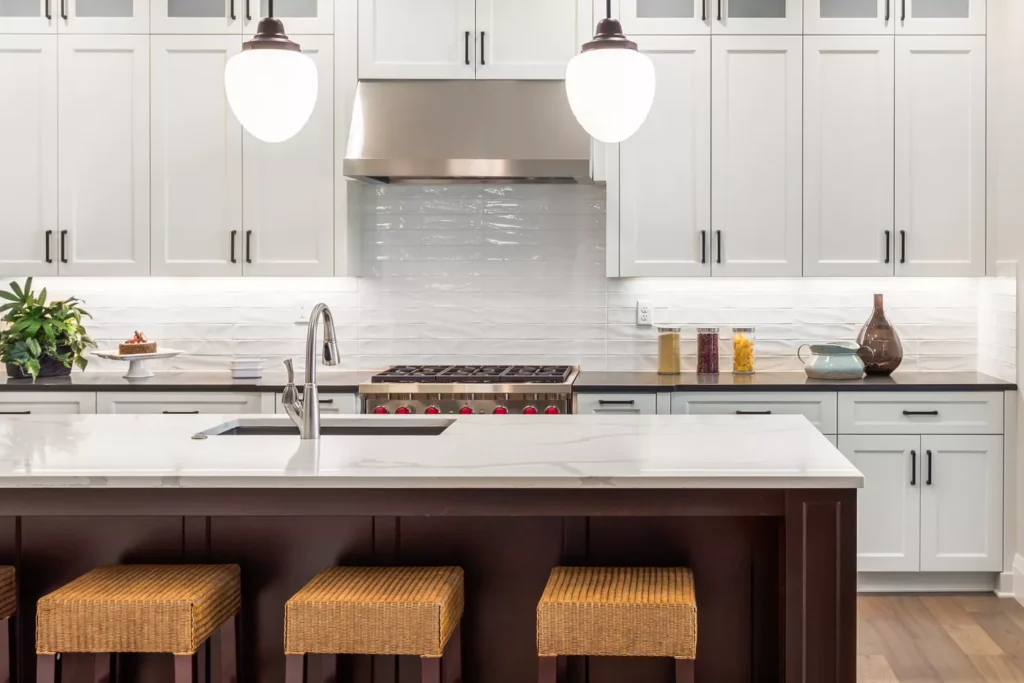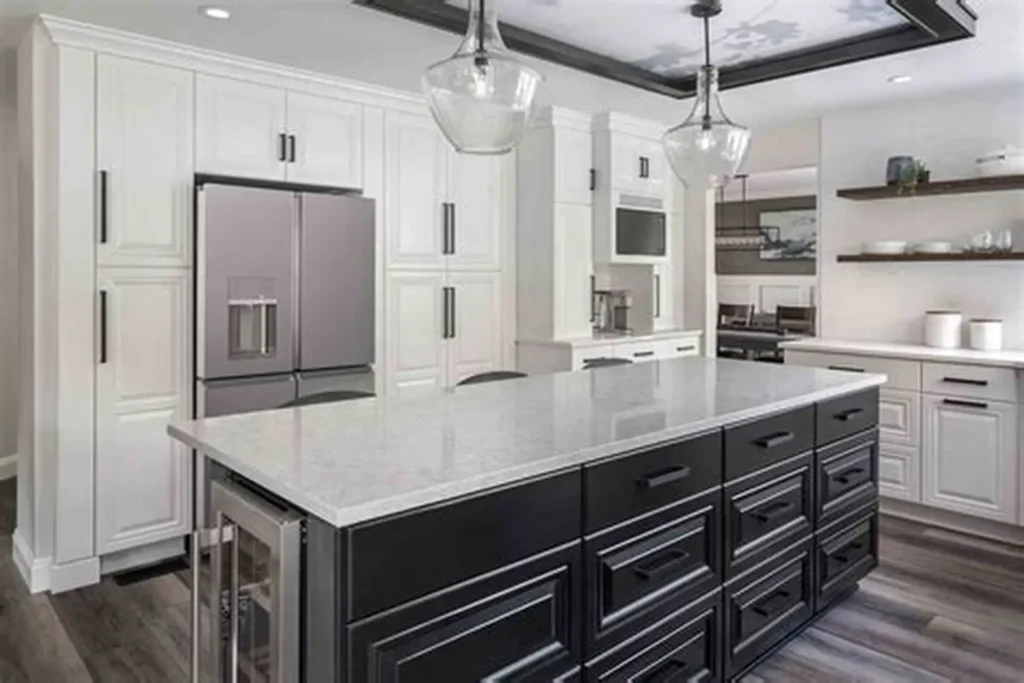Granite is beloved for its durability, heat resistance, and natural beauty—from polished white granite countertops to dramatic black granite countertops and textured granite bathroom vanities. But to keep those surfaces looking showroom-fresh, you need the right, stone-safe routine. This guide explains exactly what to clean granite with, what to avoid, and how to handle stains, disinfection, and long-term care—whether your surface is natural vs. engineered granite, glossy or honed, dark or light.

The Short Answer (What to Use)
- Everyday cleaning: A pH-neutral, non-ionic stone cleaner or warm water + a drop of dye-free dish soap (mild).
- Disinfection (as needed): A 70% isopropyl alcohol spray, left on the surface for 3 minutes, then wiped and rinsed.
- Stain removal: A stone-safe poultice (commercial product), or DIY baking soda paste (see recipes below).
- Polish/shine: A stone-safe conditioner (optional) for extra luster—never silicone waxes or generic “polishes.”
Avoid: vinegar, lemon juice, bleach, ammonia, oven cleaner, glass cleaner, abrasive powders, scouring pads, or anything labeled “descaler.” These can etch, dull, or strip sealers on granite stone.

Why Granite Needs pH-Neutral Care (A 30-Second Geology Primer)
Granite is an igneous rock made mostly of quartz and feldspar with mica and accessory minerals. That blend gives you excellent scratch resistance and heat tolerance (one reason granite is better than concrete countertops for many kitchens). But even dense granite can be micro-porous, so acidic or alkaline products can damage sealers and leave a dull “etched” look—especially on black granite countertops and honed finishes. Hence: pH-neutral cleaners plus gentle tools.
Tools & Supplies That Won’t Scratch
- Soft microfiber cloths (wash and rotate—fresh cloths reduce streaking)
- Soft non-abrasive sponge or foam pad
- Soft nylon bristle brush (for textured/antique or leathered finishes)
- Spray bottle(s) for cleaner and distilled water (helps prevent water spots)
- pH-neutral stone cleaner (labeled safe for granite)
- Optional: commercial stone poultice for stains
Handling stone slabs or heavy tops? Pros rely on specialized gear—don’t rig ad-hoc. See Toolrange and the Aardwolf Forklift Boom FB1-2720 for examples of safe material movement equipment.
Daily & Weekly Cleaning Routines
Daily (or After Cooking)
- Dry debris first. Use a dry microfiber to lift grit (protects against micro-scratches).
- Spritz cleaner. Use a pH-neutral stone cleaner or warm water + a drop of mild dish soap.
- Wipe in S-patterns. Overlap passes to avoid streaks.
- Final buff. Use a clean, dry microfiber to buff—key for black granite countertops.
Weekly (Deep Refresh)
- Repeat daily steps, then flush-rinse with distilled water and buff dry.
- Check high-use areas (around the sink, coffee station) for early stains.
DIY Granite Cleaner Recipes (Stone-Safe)
Always spot-test under an appliance or in a corner first.
1) Everyday Cleaner (Super Simple)
- 2 cups warm water
- 1–2 drops mild, dye-free dish soap
- Optional: 5–10 drops of stone-safe essential oil for scent (never citrus acids)
Mix gently to avoid suds. Spray, wipe, rinse with water, buff dry.
2) Streak-Free Rinse Spray
- Distilled water only (prevents mineral spots on dark tops)
Mist lightly after cleaning and buff—great for black granite countertops.
3) Disinfecting Spray (As Needed)
- 70% isopropyl alcohol (pre-mixed or dilute 91% with distilled water)
Spray, wait 3 minutes, wipe, then rinse and buff. Use sparingly; frequent disinfection isn’t usually necessary for residential kitchens.
Stain Removal on Granite (By Type)
Sealers resist many spills, but some stains can settle below the surface. Identify the culprit, then choose the right method.
Oil-Based (cooking oil, butter, makeup)
- Symptom: Darkened patch that looks “wet.”
- Fix: Make a poultice with baking soda + water (peanut-butter consistency). Spread ⅛–¼″ thick, cover with plastic, perforate a few pinholes, wait 24–48 hours, remove, rinse, and dry. Repeat if needed.
Organic (coffee, tea, wine, juice)
- Symptom: Brown/tan rings or blotches.
- Fix: Poultice with baking soda + 3% hydrogen peroxide (or a ready-made stone stain remover). Apply as above, check after 24 hours.
Rust (from metal canisters, tools)
- Symptom: Reddish-orange discoloration.
- Fix: Use a granite-safe rust remover (labeled for natural stone). Follow directions carefully and rinse thoroughly. Avoid generic rust gels—they can etch.
Hard-Water or Soap Film (bath vanities, around faucets)
- Symptom: Hazy film, white crust at fixtures.
- Fix: Lay a cloth soaked in warm distilled water for 5–10 minutes to soften, wipe with pH-neutral cleaner, rinse, buff. For persistent mineral buildup, use a stone-safe mineral remover.
Outdoor monuments and memorials face different chemistry (mold, lichen). For that context, see How to Clean a Granite Headstone.
How to Keep Granite Shiny (Without Waxes)
- Clean correctly (no harsh chemicals).
- Buff dry with fresh microfiber after each clean—moisture and residues cause dullness.
- Consider a stone-safe conditioner monthly for extra pop on polished granite (avoid silicone or acrylic “polishes” that attract grime).
- For professional re-hone/re-polish of worn areas (chips, etches), hire a stone pro; they’ll use diamond abrasives and slurry polishing to restore clarity.
Sealing Granite: Do You Need It and With What?
Not every granite needs frequent sealing, but most clean granite countertops benefit from periodic top-up:
- Water-drop test: Place a teaspoon of water; if it darkens and absorbs within 5–10 minutes, it’s time to reseal.
- Frequency: Typically every 1–3 years depending on color, finish, and traffic (light, honed surfaces often need it sooner).
- Product: Use a penetrating/impregnating sealer labeled for granite; avoid topical coatings.
- Application: Clean > dry > apply evenly > allow dwell per label > wipe off excess > cure time before use.
Tip: Sealer helps buy cleanup time; it doesn’t make stone stain-proof.
What Not to Clean Granite With (Common Mistakes)
- Vinegar, lemon, citrus cleaners → acid etching/dulling.
- Bleach or ammonia → sealer degradation, haze, color lightening in dark granites.
- Glass cleaner → often contains ammonia; causes streaks and dulling.
- Scouring powders, steel wool, magic erasers → micro-scratches that gather grime.
- “Descalers” or bathroom acids → etched spots, especially on honed finishes.
- Over-soaping → film that looks cloudy, especially on black granite countertops.
Special Care by Area & Finish
Kitchens (Heavy Use)
- Wipe spills immediately—especially oils, tomato sauce, wine.
- Use cutting boards—it protects knives and stone (and keeps warranties happy). Curious about cutting direct? Read Can You Chop/Cut on Granite Countertops?.
Bathrooms (Minerals & Products)
- Rinse and dry after toothpaste, cosmetics, hair products (oils, dyes, acids).
- Use a squeegee or quick towel-off around faucets to prevent mineral rings.
Finishes
- Polished: Highest stain resistance; shows streaks if not buffed dry.
- Honed/leathered: Trendy matte look; needs meticulous rinsing and occasional sealing because micro-texture can harbor residue.
Backsplashes
- Overspray from cooking? Degrease with pH-neutral stone cleaner, rinse, and buff. Avoid aerosol degreasers unless labeled safe for natural stone.
Buying & Budget Tips for Cleaners (and Where to Start)
- Choose a concentrated stone cleaner and dilute per label; it’s cost-effective for large kitchens.
- Stock microfiber packs—fresh cloths are the secret to a streak-free finish.
- Keep a small stain-removal kit: baking soda, 3% hydrogen peroxide, plastic wrap, painter’s tape, and a commercial poultice for emergencies.
- If you’re upgrading or relocating slabs, always plan safe handling. Professional lift accessories like the Aardwolf Forklift Boom FB1-2720 (and other solutions you’ll find via Toolrange) protect the stone and your crew.
Step-by-Step: The Perfect Granite Clean (Checklist)
- Dry wipe crumbs/grit.
- Spritz pH-neutral cleaner or mild soap solution.
- Wipe in overlapping passes (S-pattern).
- Rinse lightly with clean or distilled water.
- Buff dry with fresh microfiber until streak-free.
- Spot-treat any stains with the correct poultice.
- Test water-drop quarterly to decide on resealing.
FAQs (Granite vs. Other Materials)
Is granite harder to clean than quartz?
Both are simple day-to-day; granite needs the occasional sealing while quartz (an engineered surface) doesn’t. But quartz can be sensitive to solvents and high heat, while granite handles heat better. (Granite vs quartz countertops tradeoffs depend on lifestyle.)
What about “natural stone countertop comparison”—granite vs marble or soapstone?
- Marble: Softer, etches with acids—needs gentler care.
- Soapstone: Non-porous; usually oiled to enhance color; very scratchable but easy to refinish.
- Granite: Great all-rounder for kitchens—excellent balance of durability, maintenance, and price among affordable granite countertop options.
Do I need specialty products for black granite?
Not necessarily, but distilled water for the final buff helps stop mineral spotting and ghost streaks.
Related Reading & Resources
- Heavy slab moves and safe rigging: Toolrange
- Pro-grade lift accessory: Aardwolf Forklift Boom FB1-2720
- Cutting board myths & best practices: Can You Chop/Cut on Granite Countertops?
- Outdoor granite care (mold, lichen, hard water): How to Clean a Granite Headstone

